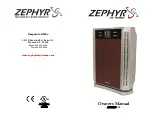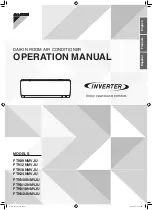
RT-SVX063E-EN
79
This function prevents the addition of circuit capacity
any time the circuit is running and Compressor Suction
Refrigerant Pressure is less than 1.4 times the normal
threshold value.
Temperature and Pressure Sensor
Failures
Each refrigeration circuit has a number of sensors that
are required for proper control of compressors and
associated head pressure control components. Should
these sensors fail, or exceed operational limits,
compressors on the given circuit will be inhibited until
the sensor values return to normal operational ranges.
An indication will be made to the user interface.
Oil Management Protection
Trio Manifolded compressors on 25 and 30 ton
standard efficiency units require an additional level of
protection for the small compressor installed in the “A”
position. When the “A” compressor has been
energized and an additional compressor has been
commanded on, a thirty minute timer is started. When
the thirty minute timer has expired, the “A”
compressor is de-energized for thirty seconds. At the
end of the thirty seconds the compressor is released to
normal control. The thirty minute timer is reset at the
end of oil management cycle.
Compressor Discharge Pressure Limit
Compressor Discharge Pressure Limit is a control
feature of Adaptive Control. This feature prevents a
circuit shutdown when the discharge pressure
approaches the high pressure cutout switch setting by
decreasing compressor capacity. This is done by
staging off fixed speed compressors on circuits with
high discharge pressure. This feature will provide
maximum capacity while preventing a high pressure
cutout.
The discharge pressure limit is based on the discharge
pressure percentage relative to the high-pressure
cutout setting. This limit is active when the circuit is
running.
If the discharge pressure limit is preventing loading,
holding or forcing unloading, an indication will be
made to the user interface.
N
No
otte
e:: Note: The discharge pressure limit function
assumes that all available condenser fans are
running and limiting compressor capacity is the
only option left.
Compressor Discharge Saturated
Temperature Limit
Compressor Discharge Saturated Temperature Limit is
a control feature of Adaptive Control for variable speed
compressors only. This circuit-level feature applies
when the discharge saturated temperature approaches
the compressor operating threshold limit for high
discharge saturated temperature. Limit control action
modifies the normal capacity modulation to decrease
capacity by reducing compressor speed.
Compressor Discharge Saturated
Temperature Speed Limit
Compressor Discharge Saturated Temperature Speed
Limit is a control feature of Adaptive Control for
Danfoss VZH variable speed compressors only. This
circuit-level feature applies when the discharge
saturated temperature approaches the compressor
operating threshold limit for high discharge saturated
temperature. Limit control action modifies the
allowable compressor speed range.
High Suction Saturated Temperature
Inhibit
High Suction Saturated Temperature Inhibit is a control
feature of Adaptive Control for variable speed
compressors. This circuit-level feature applies when
the suction saturated temperature exceeds the
compressor operating threshold limit for suction
saturated temperature. Inhibit control action de-
energizes the variable speed compressor when the
suction saturated temperature exceeds the operating
threshold design limit.
When this function is Active, an indication will be made
to the operator.
Compressor Involute Pressure
Differential Protection
Compressor Involute Pressure Differential Protection is
a control feature of Adaptive Control for variable speed
compressors. Scroll compressors have a limitation on
the pressure difference between the opposite sides of
the involute tip near the center of the scroll
(compression ratio). High values of compressor
involute pressure differential may cause compressor
fatigue. Its associated limit will attempt to allow the
unit to run safely at partial capacity without tripping the
circuit on a diagnostic. The compressor must be
restricted from running in this condition.
When this function is active, an indication will be made
to the user interface. Depending on severity, both
instant and delayed shutdowns are possible.
Shutdowns may be temporary or require a manual
reset.
Loss of Charge Detection
This function detects excessive refrigerant leakage.
Units can operate in a low charge condition for an
extended period where the loss of charge is not
enough to trigger the normal loss of charge protection.
If the charge continues to fall slowly, a subsequent start
could result in variable speed compressor damage.
Loss of Charge Detection works in concert with
Superheat High Limit Detection.
S
Se
eq
qu
ue
en
ncce
e o
off O
Op
pe
erra
attiio
on
n
















































